人教版英语八年级上册unit 7 reading
人教版初中初二八年级英语上册 名师教学课件 Unit7 Will people have robot

Which side do you agree, why?
I agree/ disagree with James White. Because I think/ believe…… I agree/ disagree with other scientists. Because ……
They can take people’s temperature and remind people to wear masks.
There are some other robots, what can they do ?
Do you think you will have your own robot?
like humans
the future?
have many different shapes
like animals
What will your robot look like? What will it be able to do to help you?
Work in groups!
Design your own robots.
What are robots like in movies? (robots in movies)
in movies about the
future
robots
Paragraph 1
Paragraph 1: Read and answer:
1.What are the robots like in the movies?
We want to have a robot. It will look like… It will be able to…
八年级英语人教版上册Unit7WillpeoplehaverobotsReading教学设计
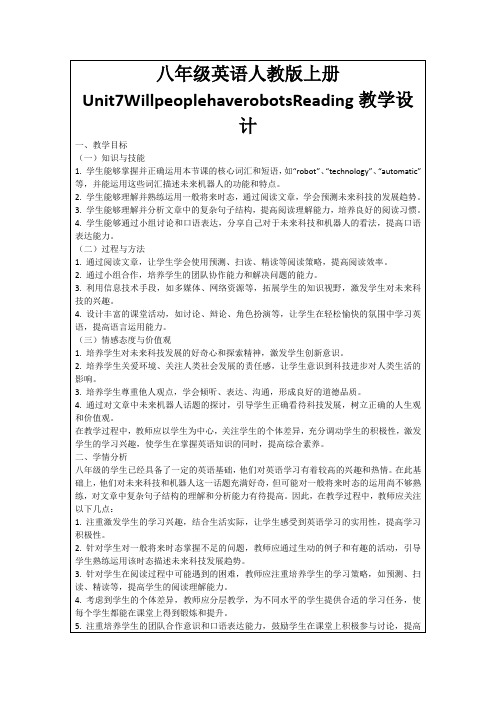
3.学生跟随教师一起阅读文章,了解未来机器人的发展前景,并学习文章中的复杂句子结构。
4.教师针对文章内容进行讲解,帮助学生理解作者对未来科技的观点和态度。
(三)学生小组讨论
1.教师将学生分成小组,让他们讨论以下问题:
a.预测:让学生根据文章标题和图片,预测文章内容。
b.扫读:让学生快速阅读文章,找出关键信息,如未来机器人的功能、优点等。
c.精读:让学生深入阅读文章,分析复杂句子结构,理解作者对未来科技的看法。
4.组织小组讨论,让学生分享自己对于未来科技和机器人的看法,提高口语表达能力,同时培养团队合作意识。
5.设计写作任务,让学生运用所学知识描述自己心中的未来机器人,巩固一般将来时态的运用,并提高写作能力。
6.课堂总结环节,教师引导学生反思本节课的学习内容,强化重点知识,并针对学生的表现给予评价和反馈。
在教学过程中,教师应注意以下事项:
1.关注学生的个体差异,给予每个学生充分的关注和指导,确保他们在课堂上有所收获。
2.创设轻松愉快的课堂氛围,鼓励学生积极参与课堂活动,提高他们的自信心。
3.注重启发式教学,引导学生主动探究,培养他们的创新意识和解决问题的能力。
a. What are the advantages and disadvantages of robots in the future?
b. How will robots change our lives in the future?
2.各小组汇报讨论成果,教师给予评价和指导。
3.教师组织学生进行角色扮演活动,模拟未来生活中与机器人的互动,提高口语表达能力。
Unit7 SectionB reading说课稿人教版八年级英语上册

Unit 7 Will people have robots?Section B ReadingDo You Think You Will Have Your Own Robot?说课稿我说课的课题是《Unit7 Will people have robots?》Section B 第二课时的阅读教学,下面我将从教材的地位、学情分析、教学目标、教学重难点、教法与学法、教学过程、作业布置、板书设计和教学反思等环节来进行我的说课。
一、说教材地位和学情分析本节课是八年级上第七单元,本单元围绕学生的“未来生活”为话题展开教学。
目的是让学生想象未来的生活方式,并能够灵活运用“will+动词原形”的方式对将来的事进行语言表达。
本课时主要是通过阅读短文,让学生体会到科技发展给人类带来的帮助,尤其是机器人在未来工作生活中对人们的作用,并通过中国最新科技的发展的展示,使学生树立文化自信。
同时训练学生的阅读能力和对一般将来时的运用能力。
学情分析:经过一年多的英语学习学生已具有了一定的英语综合能力,也积累了一定的英语词汇量。
13—14岁的孩子想象力丰富,有一定的语言基础,但害怕阅读,阅读策略欠缺。
二.说教学目标(一)根据新课程标准要求,本节课的知识目标:1. 学生通过阅读,了解含有will的一般将来时对机器人发展的预测,完成阅读活动。
2. 能够使用含有will的一般将来时基本句型,表达对未来机器人的预测。
3. 学习词汇even, human, servant, dangerous, already, factory, simple, over and over again, believe, hundreds of, inside, disagree, shape, fall down, look for, possible, impossible过程与方法:采用小组合作的学习策略,通过听说读写在阅读中所获取到的信息,小组合作展现对未来机器人的预测。
【拓展阅读】英语人教版八年级上册 Unit7_Life_in_the_future
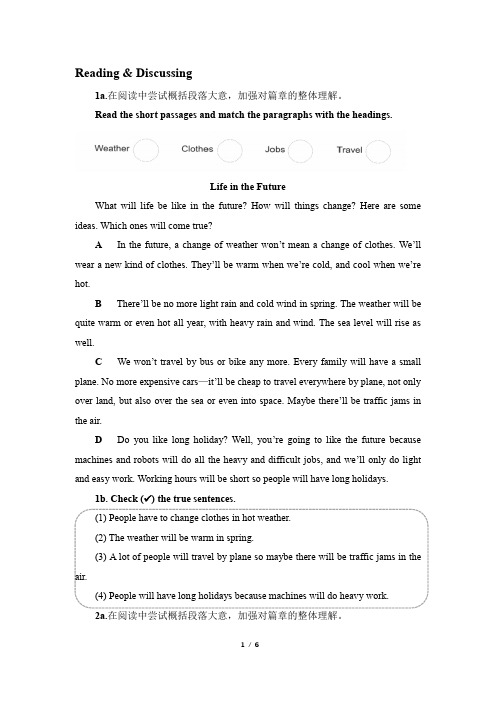
Reading & Discussing1a.在阅读中尝试概括段落大意,加强对篇章的整体理解。
Read the short passages and match the paragraphs with the headings.Life in the FutureWhat will life be like in the future? How will things change? Here are some ideas. Which ones will come true?A In the future, a change of weather won’t mean a change of clothes. We’ll wear a new kind of clothes. They’ll be warm when we’re cold, and cool when we’re hot.B There’ll be no more light rain and cold wind in spring. The weather will be quite warm or even hot all year, with heavy rain and wind. The sea level will rise as well.C We won’t travel by bus or bike any more. Every family will have a small plane. No more expensive cars—it’ll be cheap to travel everywhere by plane, not only over land, but also over the sea or even into space. Maybe there’ll be traffic jams in the air.D Do you like long holiday? Well, you’re going to like the future because machines and robots will do all the heavy and difficult jobs, and we’ll only do light and easy work. Working hours will be short so people will have long holidays.1b. Check (✓) the true sentences.2a.在阅读中尝试概括段落大意,加强对篇章的整体理解。
人教版英语八年级上册Unit7SectionBReading优秀教学案例
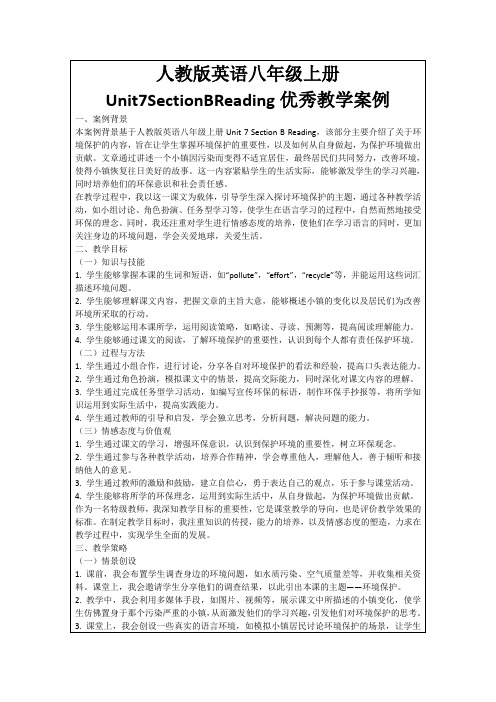
作为一名特级教师,我深知教学目标的重要性,它是课堂教学的导向,也是评价教学效果的标准。在制定教学目标时,我注重知识的传授,能力的培养,以及情感态度的塑造,力求在教学过程中,实现学生全面的发展。
三、教学策略
(一)情景创设
1.课前,我会布置学生调查身边的环境问题,如水质污染、空气质量差等,并收集相关资料。课堂上,我会邀请学生分享他们的调查结果,以此引出本课的主题——环境保护。
在本案例中,我将所学的知识与学生的实际生活紧密结合,通过各种教学活动,如编写宣传环保的标语,制作环保手抄报等,让学生将所学的知识运用到实际生活中。这样的教学内容实践性不仅能够提高学生的语言运用能力,还能够培养他们的实践能力和创新精神。通过实践性的教学内容,学生能够更好地理解和感受到环境保护的重要性,从而激发他们的环保意识和行动力。
(三)小组合作
1.课堂上,我会组织学生进行小组讨论,让他们分享自己的观点和经验,如“你认为环境保护的重要性是什么?”“你曾经为保护环境做过哪些努力?”等。
2.学生可以通过小组合作,共同完成一些任务,如编写宣传环保的标语,制作环保手抄报等,从而提高他们的合作能力和实践能力。
3.在小组活动中,我会引导学生尊重他人,理解他人,善于倾听和接纳他人的意见,培养他们的团队精神。
在教学过程中,我以这一课文为载体,引导学生深入探讨环境保护的主题,通过各种教学活动,如小组讨论、角色扮演、任务型学习等,使学生在语言学习的过程中,自然而然地接受环保的理念。同时,我还注重对学生进行情感态度的培养,使他们在学习语言的同时,更加关注身边的环境问题,学会关爱地球,关爱生活。
二、教学目标
(一)知识与技能
人教新目标英语八年级上册unit7 SectionB (3a-3c)教案

人教新目标英语八年级上册Unit 7 Will people have robots?(Section B 3a-3c)Teaching aims:1.Knowledge and abilities:(1)students can master the new words: probably, during,holiday, possible.(2)By reading 3a,studentsn can master the usage of theSimple Future Tense in the passage, understand the writer`s contents、master the set phrases and conjunctions .(3)Students can practice listening and speaking. (3b)(4)Students can use the Simple Future Tense correctly todescribe their future life. (3c)2.Procedures and ways:Multi-media teaching /task-based language teaching/groupworkFirst ,Students can read the passage to master some writing skills .Then ,students finish 3b to master more details about writing.Finally, students can write a composition about their future life.3.Emotion 、attitude and valueEveryone should have his dream and try his bet to realize them。
初中八年级英语上册第七单元同步课文讲解

初中八年级英语上册第七单元同步课文讲解以下是初中八年级英语上册第七单元同步课文讲解,供您参考:标题:掌握未来:如何学好英语一、导言本文将探讨如何学好英语。
随着全球化的加速,英语成为一项必备技能。
掌握好英语,将有助于我们在未来的职业生涯中取得成功。
二、学好英语的关键要素1. 词汇积累词汇是语言的基础,扩大词汇量是学好英语的关键。
学生应积极记忆常用单词和短语,并尝试在日常生活中使用。
2. 语法理解掌握语法规则对于正确使用英语至关重要。
学生应深入理解英语的基本语法规则,并尝试在实际对话和写作中运用。
3. 听力训练听力是语言学习的关键部分。
通过观看英语电影、听英语歌曲和播客等方式,提高英语的听力理解能力。
4. 口语练习口语练习对于提高英语交际能力至关重要。
学生应积极参与英语角、语言交流活动等,提高口语表达能力。
5. 阅读理解阅读是获取知识和提高语言能力的有效途径。
学生应广泛阅读英文原著、新闻报道等,提高阅读速度和理解能力。
三、学习方法建议1. 制定学习计划:设定明确的学习目标,规划好每天的学习时间,确保英语学习成为日常生活的一部分。
2. 创造语言环境:尽可能多地接触英语,如观看英文电影、听英文歌曲、阅读英文原著等,以提高英语学习的兴趣和效率。
3. 积极参与课堂:在课堂上积极参与讨论和活动,与老师和同学进行交流,提高英语实际应用能力。
4. 多维度学习:利用多种学习资源,如网络课程、英语学习软件等,从多个角度学习英语,加深理解和记忆。
5. 反思与调整:定期回顾自己的学习进展,找出不足之处,调整学习方法,以提高学习效果。
四、结语学好英语需要长期坚持和实践。
只有通过不断积累和实践,我们才能真正掌握英语,为未来的职业生涯做好准备。
希望本文对大家有所帮助,祝愿大家在学习英语的道路上取得成功!。
英语八上《Unit 7 Memory Reading“Memory Corner“》_9

8A U7 Reading Memory CornerLesson Plan(缩减版)学科:初中英语版本: 牛津上海版本课内容来自牛津英语上海版八年级上册第7 单元的阅读板块。
此单元以“记忆”为话题,以提高记忆力的方法为主线。
阅读(Reading)板块中主阅读篇章的体裁为说明文,本课作为阅读课的第一课时,以引导学生了解主阅读篇章的主旨大意及深入理解文本细节为主要目标。
语言知识目标:能掌握并运用:memory, trouble, list, method, improve, mention.语言技能目标:1.能在阅读过程中熟练运用阅读微技能(预测predicting; 略读skimming;扫读scanning和细节阅读reading for details)。
2.能与小组成员讨论并总结出课文主人公Henry, Paula, Millie 关于提高记忆力的方法。
情感目标:积极与人合作,探索适合自己的记忆方法。
●教学重点:能通过阅读了解和掌握三种有效的记忆方法。
●教学难点:1) A great way to help you remember something is to imagine a picture of it inyour mind.2) If you make the picture big, strange, or silly, you will remember it better.●Students analysis:本课的教学对象为初二学生, 在学习本课之后,他们更能阅读与理解关于科学的文章,为本单元后面的More Practice的教学做好铺垫。
●Teaching methods: Task-based teaching methodology, discussing method ofteaching;●Learning strategy:Communicative learning strategy.●Use of media:VCR, PPT, Flash, Blackboard,student sheetsTeaching procedures。
人教版八年级英语上册说课稿UNIT 7 Period 1 (Section A 1a-2c)

人教版八年级英语上册说课稿UNIT 7 Period 1 (Section A 1a-2c)一. 教材分析人教版八年级英语上册Unit 7 Period 1(Section A 1a-2c)主要讨论了关于野生动物的保护问题。
通过本节课的学习,学生将了解到野生动物面临的威胁以及我们应该如何保护它们。
教材通过丰富的插图、情景对话和阅读材料,使学生在轻松愉快的氛围中掌握相关词汇和语法知识,提高口语表达能力和阅读理解能力。
二. 学情分析八年级的学生已经具备了一定的英语基础,能够理解和运用一些基本的词汇和语法知识。
但他们在口语表达和阅读理解方面还存在一定的困难。
因此,在教学过程中,教师需要关注学生的个体差异,针对不同学生的学习需求进行有针对性的教学。
三. 说教学目标1.知识目标:学生能够掌握本节课所学的词汇和语法知识,如 wildanimal, protection, hunting 等。
2.能力目标:学生能够运用所学知识进行口语表达和阅读理解,提高英语应用能力。
3.情感目标:学生能够认识到保护野生动物的重要性,培养关爱动物、保护环境的意识。
四. 说教学重难点1.重点:本节课的重点是让学生掌握与野生动物保护相关的词汇和语法知识。
2.难点:学生如何在实际语境中运用所学知识进行口语表达和阅读理解。
五. 说教学方法与手段1.交际法:通过情景对话,让学生在实际语境中练习英语口语,提高交际能力。
2.阅读理解:通过阅读关于野生动物保护的文章,培养学生的阅读理解能力。
3.任务型教学法:通过小组讨论、展示等活动,激发学生的学习兴趣,提高合作能力。
六. 说教学过程1.导入:教师通过展示一些野生动物的图片,引导学生谈论关于动物的话题,激发学生的学习兴趣。
2.presentation:教师讲解新词汇和语法知识,如 wild animal,protection, hunting 等。
3.practice:学生进行情景对话练习,运用所学知识进行口语表达。
人教版英语八年级上册Unit7SectionBReading教学设计

3.现在进行时态的运用:学生需要掌握现在进行时态的用法,并能够运用现在进行时态描述正在进行的动作或状态,以及进行相关的提问和回答。
(二)教学设想
1.针对词汇和短语的学习,教师可以设计一些有趣的游戏和活动,如词汇接龙、看图猜词等,以激发学生的学习兴趣,帮助他们更好地记忆和理解词汇。
4.语法练习:要求学生运用本节课所学的现在进行时态进行写作或填空练习。通过这个作业,学生可以巩固现在进行时态的用法,提高语言运用能力。
在布置作业时,教师要考虑学生的个体差异,设置不同难度的作业,以满足不同学生的学习需求。同时,教师要鼓励学生积极参与作业的完成,给予他们足够的时间和支持。在批改作业时,教师要及时给予反馈和评价,指出学生的错误,并给予正确的指导。
此外,本节课还将培养学生合作学习和自主学习的能力。学生将在小组活动中相互合作,共同完成任务。同时,教师会鼓励学生在课堂上积极思考和表达自己的观点,以提高他们的自主学习能力。
二、学情分析
八年级的学生在英语学习方面已有一定的基础,他们已经掌握了基本的语法知识和一些日常用语。他们对英语学习充满热情,但同时也存在一些问题。首先,他们的阅读理解能力有待提高,特别是对于长篇文章的理解。其次,他们在语言运用方面还存在一定的困难,如语法结构和词汇的运用。因此,在教学过程中,教师需要针对这些问题进行有针对性的教学设计,以帮助学生更好地理解和运用英语。
(三)学生小组讨论
在学生对文章内容有了初步理解之后,教师可以组织学生进行小组讨论。教师可以提出一些问题,如“你们认为是什么原因导致这些动物面临威胁?你们认为我们应该如何保护它们?”等问题,引导学生进行深入思考和交流。通过小组讨论,学生可以培养合作学习的能力,提高他们的语言表达和思维能力。
人教八上Unit7Reading教学设计

为了巩固本节课的学习内容,培养学生的自主学习能力,特布置以下作业:
1.完成课后练习册中与本节课相关的练习题,包括填空、选择、改错等形式,旨在帮助学生巩固过去时态的运用、目标词汇和句型的掌握。
2.根据本节课所学内容,编写一个小故事,描述过去的一段经历。要求运用过去时态,尽量使用所学目标词汇和句型。此作业旨在提高学生的写作能力,同时巩固所学知识。
3.教师设置情境,让学生进行角色扮演,运用所学知识进行对话,巩固语法和词汇。
4.教师针对文章中的难点进行详细讲解,帮助学生理解和掌握。
(三)学生小组讨论,500字
1.教师将学生分成小组,针对文章内容进行讨论,要求每个小组成员分享自己的看法和理解。
2.教师提出讨论话题,如:“Can you describe the little boy's feelings during his summer vacation?”各小组成员积极发表意见,共同完成任务。
3.引导学生运用阅读策略,提高阅读效率,提升文章理解能力;
4.创设真实的语言环境,让学生在实践中提高语言运用能力;
5.关注学生的个体差异,给予个性化指导,提高他们的自信心和学习动力。
三、教学重难点和教学设想
(一)教学重难点
1.教学重点:
-掌握与过去事件相关的时态,如一般过去时、过去进行时和过去完成时;
人教八上Unit7Reading教学设计
一、教学目标
(一)知识与技能
本节课是人教版八年级上册Unit 7 Reading的教学设计。通过本节课的学习,学生应掌握以下知识与技能:
1.能够理解并运用与过去事件相关的时态,如一般过去时、过去进行时和过去完成时;
2.能够通过阅读文章,获取、整理并运用文章中的关键信息;
Unit7SectionB2b课件人教版八年级英语上册

②尽量别把她弄醒。
Try not to w__a_k_e _h_er_u_p_.
1234 知识点
练习
导读 泛读 精读 重难点 复述
句意: 用法:
Eg:
拓展: Eg:
3. However, they agree it may take hundreds of years.
_然__而__,__他__们__一__致__认__为__这__或__许__会__需__要__数__百__年__的__时__间__。__
1. Today there are already robots working in factories.
句意: __如__今__,__已__经__有__机__器__人__在__工__厂__里__工__作__了__。
用法1: 本句的句式结构为:T_h_e_r_e_i_s_/a_r_e_s_b_./_s_th_._d_o_i_n_g_s_t_h_. _,意为有__某__人__/_某__物__
help look for people under the buildings. T 4. It’s easy for a robot to wake up and know where they are. F
Task 1 Task 2 Task 3 Task 4 Task 5
导读 泛读 精读 重难点 复述
hundreds of表笼统的数量,意为_许__多__;__大__量__,不可与_具__体__数__字_连
用;而hundred则表具体数量,意为_百___,前有具体数字时,后不 加__s__也不和__o_f_连用。 ①这个阅览室能容纳200人。
The reading room can hold _tw__o _h_u_n_d_r_e_d _p_e_o_p_l_e_.
人教英语八年级上册 Unit7Reading(共16张PPT)
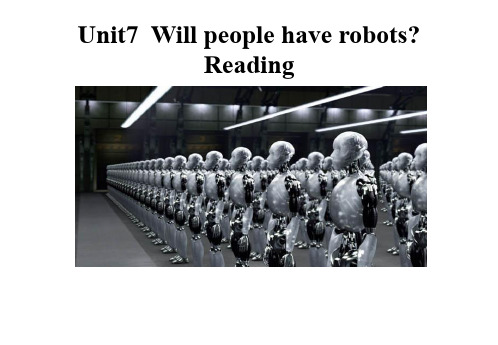
e the Internet to find more information about robots.
2. Write a short passage about the robot your group design.
Discussion :Which side do you agree with?
Opinion 1: Some scientists believe that although we can make robots move like people, it will be difficult to make them really think like a human. Opinion 2: Many scientists think that robots will be able to think like humans and even talk like humans iinn 2th5etone5a0r yfuetaurrse..
Now
In the future
1.Robots can build cars in factories.
2.They can do simple jobs many times and never get bored.
3. Some can __w_a_l_k__ and _d_a_n_c_e_.
We never know what will happen in the future. Everything will be _p_o_s_si_b_le__. Nothing will be__im_p_o_s_s_i_b_le_ .
Design (设计)your robot and write a short passage about it.Your passage should include (包括)the following information.
人教版英语八年级上册 Unit 7 Section B Reading课件
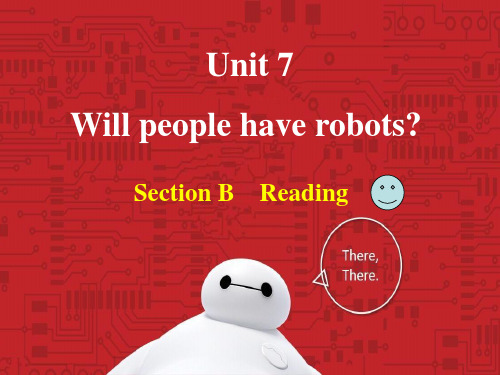
4. It’s hard for us _____ the same thing over and over
again.
A. to do B. do
C. doing D. does
Talk about the robots with your friends and family. Write down your dream robots
more look like _h_u_m__a_n_s_ .
_d_if_f_ic_u_l_t to make robots really
For example, some robots in
_t_h_in_k_ like a human. For example,
Japan can __w_a_l_k__and__d_a_n_c_e__. They think robots will even be
we can. For example, he thinks that robots will
_n_e_v_e_r_ be able to wake up and know where they are. Which side do you _a_g_r_e_e_ with?
2e Discussion
ew 3a-4 on page 55-56.
(略读)
Paragraph 1
Will robots think like humans in the future?
Paragraph 2 Paragraph 3
What will robots be like in the future?
Paragraph 4
What can robots do today?
人教版英语八年级上册:Unit 7 Section B Reading课件
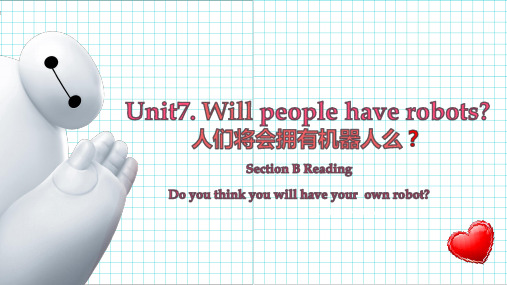
1. When we watch movies about the future, we sometimes see robots. They are usually like human servants. They help with the housework and do jobs like working in dirty or dangerous places.
SUMMER TIME
What other things can robots do ? What do they look like? Where do you usually see robots?
Look at the title and the picture, and predict what you will read about.
Para. 1 Para. 2 Para. 3 Para. 4
Will robots think like humans in the future? Whatfuture?
What can robots do today?
What are robots like in movies?
people under the buildings…
Para. 4 A. Will robots think like humans in the future? B. What will robots be like in the future? C. What can robots do today? D. What are robots like in movies?
• A. It’s about a science fiction movie.
• B. It’s about the robot scientist James White.
八年级英语上册-Unit-7-Memory-Readingppt课件
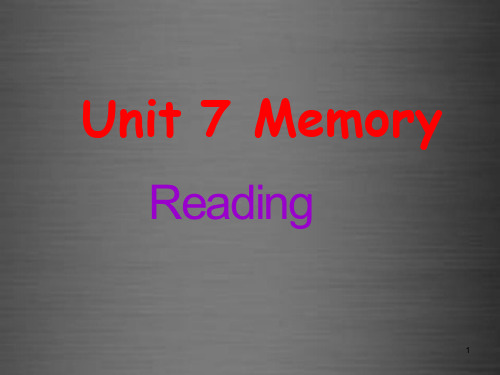
• 4 Once we learn how to ride a bike, we will never forget how to do it. T / F
• B Before you read
• Look at the introduction, the title and the first sentence
• his study.
19
• 5. It is easier to remember these steps if you understand how the water cycle works.
• 如果你理解水循环是怎么工作的, 记忆这些步骤就会简单些。
• It 做形式主语,动词不定式to remember these steps 做真正
and fill in the blanks below.
30
• Henry To remember something
Imagine a (1)_ ict__u_r_e___: (2)
big , (3)__s_t _e_____, or (4)si__ll_y___ (e.g) “smile”:
我们应该找一个最好的方法去解决 这个数学问题。
imagine a picture 想象一幅图 in your mind 在你的脑海里
Please keep this word in your mind.请你把这个记在脑海里。
13
• 2. We can imagine there is a “mile” between the first letter and the last letter.
Unit 7 Memory
Reading
1
新编人教版八年级英语上册第七单元2d ppt课件

Everyone should play a part in saving the
earth.
新编人教版八年级英语上册第七单 元2d
1. environment n. 环境
e.g. Our living environment is
much better now. 现在我们的生活环境好多了。
2. planet n. 行星 earth n. 地球
新编人教版八年级英语上册第七单 元2d
4.So what will the future be like?
What’s…like? 意为“…怎么样?” like 介词 意 为“ 像,相似”
Eg: What’s the weather like today? What will the weather be like tomorrow?
新编人教版八年级英语上册第七单 元2d
2. Everything will be free. 任何东西都是免费的。 be free 在这里表示“免费的”。另外“ be free” 还有“ 空闲的” 意思。
e.g. Admission is free for children under 9. 九岁以下儿童免费入场。
Read the conversation
2d and answer the
questions. 1. What will the future be like in the
book?
Cities will be more crowed and polluted. There will be fewer trees and environment will be in great danger.
1. Will people use money in 100 years? 一百年后人们还会使用钱吗? 这里的 in 100 years “在...期间;在...以后”后 接一段时间表示在将来某段时间之后。
(完整word版)八上Unit7阅读课说课稿
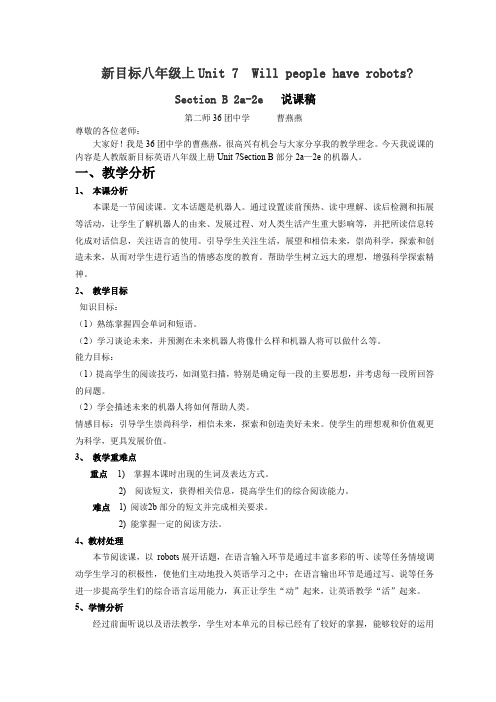
新目标八年级上Unit 7 Will people have robots?Section B 2a-2e说课稿第二师36团中学曹燕燕尊敬的各位老师:大家好!我是36团中学的曹燕燕,很高兴有机会与大家分享我的教学理念。
今天我说课的内容是人教版新目标英语八年级上册Unit 7Section B部分2a—2e的机器人。
一、教学分析1、本课分析本课是一节阅读课。
文本话题是机器人。
通过设置读前预热、读中理解、读后检测和拓展等活动,让学生了解机器人的由来、发展过程、对人类生活产生重大影响等,并把所读信息转化成对话信息,关注语言的使用。
引导学生关注生活,展望和相信未来,崇尚科学,探索和创造未来,从而对学生进行适当的情感态度的教育。
帮助学生树立远大的理想,增强科学探索精神。
2、教学目标知识目标:(1)熟练掌握四会单词和短语。
(2)学习谈论未来,并预测在未来机器人将像什么样和机器人将可以做什么等。
能力目标:(1)提高学生的阅读技巧,如浏览扫描,特别是确定每一段的主要思想,并考虑每一段所回答的问题。
(2)学会描述未来的机器人将如何帮助人类。
情感目标:引导学生崇尚科学,相信未来,探索和创造美好未来。
使学生的理想观和价值观更为科学,更具发展价值。
3、教学重难点重点1) 掌握本课时出现的生词及表达方式。
2) 阅读短文,获得相关信息,提高学生们的综合阅读能力。
难点1) 阅读2b部分的短文并完成相关要求。
2) 能掌握一定的阅读方法。
4、教材处理本节阅读课,以robots展开话题,在语言输入环节是通过丰富多彩的听、读等任务情境调动学生学习的积极性,使他们主动地投入英语学习之中;在语言输出环节是通过写、说等任务进一步提高学生们的综合语言运用能力,真正让学生“动”起来,让英语教学“活”起来。
5、学情分析经过前面听说以及语法教学,学生对本单元的目标已经有了较好的掌握,能够较好的运用目标语言进行一系列的听说活动,表达自己的思想,这为接下来的阅读课打下来良好的基础。
- 1、下载文档前请自行甄别文档内容的完整性,平台不提供额外的编辑、内容补充、找答案等附加服务。
- 2、"仅部分预览"的文档,不可在线预览部分如存在完整性等问题,可反馈申请退款(可完整预览的文档不适用该条件!)。
- 3、如文档侵犯您的权益,请联系客服反馈,我们会尽快为您处理(人工客服工作时间:9:00-18:30)。
…help look for people under the buildings if buildings fall down
Think about more shapes
Discuss in groups
First draw your robot on the piece of paper . Then choose one student to introduce it to us and put your robot on the blackboard . You may begin like this: My robot will look like____________________It will be able to________________________.It will work for students/teachers/the blind/policemen ...It will work at home/at school...If you want to use it ,…
help to build cars/ do simple jobs/ never get bored walk and dance like people/ fun to watch
In Japan
Humans
In India
Snakes
help look for people under the buildings.
15 Seconds
True or False?
(2 points)
Some scientists thinks that there will be less robots in the future, but they it may take hundreds of years. F
25 Seconds
James White believes that robots will not be able to do the _______ things as we can. For example, he thinks that robots will ______ be able to wake up and know where they are. Which side do you ________ with?
25 Seconds
Scientists are now trying to make robots ____humans and do the ______as we do. (2 points) A. look different from, same things B. look like, different things C. look like, same things
Task 3
Quick respond
For example:
True or False?
(2 points)
The passage mainly talks about robots in the future.
T
25 Seconds
True or False?
(2 points)
The robots in the movies are usually like human servants. They help with the homework and do jobs like working in safe places. F
Paragraph 4
more 1. Some scientists believe that there will be fewer robots in the future.
2. In the future some robots will look like humans ,others might look like F animals. 3. If buildings fall down with people inside, these snake robots can help T look for people under the buildings. puters and rockets also seemed possible 100 years ago.
Retell in pairs
some scientists…although ...difficult... many scientists…will even be able ...
robots in movies
are like… help with… and do jobs …
robots today
Will robots think like humans in the future?
For some scientists For many scientists
Different opinions It will be difficult to make them really think like a _________________________________ human. __________________________________
Read and answer
Paragraph 2
They What can help can they to build do today? cars and they do simple jobs over and over again.
Fill in the form
Paragraph 3
Para 3 Para 4
What are robots like in movies?
Be like In the movies
Human servants
Can do
help with the housework/ do jobs like working…
In the factories
Human servants
15 Seconds
True or False?
(2 points)
Some scientists belive that it is easy to make them think like a human.
F
25 Seconds
Scientist James White thinks that robots in the future can ___________________. (2 points) A. walk and dance B. think like a human C. wake up and know where they are D. talk to a human
will
T
impossible
F 5. In the writer's opinion, robots will not think like humans in the future. F
Task 2
Read the article quickly and complete the sentencs.(3 mins)
15 Seconds
Task 4
6mins
dancelike people. Some robots are very human-like. They can walk and ______ make robots more like Some scientists think that in the future they will _______ happen humans. This may not _______ in the near future, but at some point, robots talk like people. However, some scientists ________. disagree will even be able to ______
Unit 7 Will people have robots?
SectБайду номын сангаасon B Reading
Task 1
Para 1
Para 2
1.Read the article and match each paragraph with its main idea. (3 mins) Will robots think like humans in the future? What will robots be like in the future? What can robots do today?
help to build… do simple jobs…
opinions
robots in the future
there will be… have...shapes Some…others…
Discuss in pairs
What can they do in this article? … help with housework …do jobs like working in dirty or dangerous places …help do build cars …do simple jobs over and over again …walk and dance
Read and answer
Paragraph 1
1.Whatare 1.They arelike the robots humanlike servants. in movies?
2.They can 2.What canhelp they with do in the movies? housework and do jobs like working in dirty or dangerous places.
